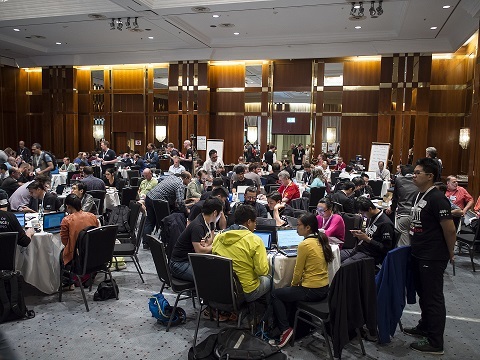The place where the future of the Internet is being created

A week has passed since my second trip to the IETF, my thoughts and emotions subsided a bit, and I decided to share my impressions of the IETF.
What is an IETF?
A bit of history. Many people know that at the dawn of the Internet, there was an ARPAnet network that connected university networks in the United States. But only a few are aware that ARPAnet was far from the only prototype network - at that time, DecNET, IPX / Netware, SNA, etc. existed at the same time as ARPAnet. These were incompatible networks, each of which was a “thing in itself”. However, over time, all these networks were absorbed by ARPAnet, the fundamental difference of which was the openness of data transmission standards and abstraction from the internal structure of different networks. This led to the emergence of a modern model of the Internet - network networks or networks of autonomous systems. Along with the rapid growth in the number of autonomous systems, openness was no longer enough - quality, extensibility and maintaining backward compatibility became important.
Initially, the IETF was organized with the support of the US government, but in 1993 there was a transformation into an international public organization in association with the Internet Society. The IETF has found a very radical solution to the problem of independence from manufacturers, regulators and jurisdictions - the IETF as a legal entity. the face does not exist. Absolutely. Those. There is an IETF Secretariat, which performs administrative functions - supporting the site and the mailing system, holding conferences, but the activities of the participants remain “volunteer”, and neither the group leaders nor the curators of referral directions receive IETF salaries.
How do standards come about?
The path of any standard begins with an idea, which is then put on a formal description. Thus, a draft of the new standard (draft) is obtained. After that, the draft is sent for consideration and revision to the working group that oversees this topic. If the working group does not exist, and the number of stakeholders is more than one, there is the opportunity to create a new working group. If the working group decides on the successful completion of the draft, it is sent for review by the IESG, the curators of the areas. After completing this step, IANA allocates the necessary values (if they are required) - and here it is, the finished standard (RFC). More details can be found in the RFC , which describes the creation of RFC.
Over the 30 years of its existence, several thousand standards have been developed within the framework of the IETF, but even more proposals were “frozen” in a draft state, i.e. not approved by the community. One way or another, it is the IETF that can be praised / blamed for the appearance of such hits as BGPv4, IPv6, BCP38 and two versions of the pigeon mail delivery protocol (see here and here ).

Why participate in the IETF?
In my opinion, there are at least two reasons for this:
- Firstly, not all IETF participants are people from the industry today, but their activities directly affect the industry today-tomorrow-the day after tomorrow. Therefore, if you do not want to see unwanted changes in your favorite protocol or a new version of IPvXXX, get involved.
- Secondly, you can offer a solution to some technical problem and make this proposal become a new standard, and the world as a result will be a little better. For example, Qrator Labs is currently working on the issue of creating Route Leak protection in BGP at the IETF . This is not to say that it is simple, and even more so quickly, but the road will be overpowered by the traveler.
Separately, it is worth mentioning the attempts to popularize, which the IETF conducts in conjunction with the ISOC. The Internet Society Fellowship to IETF program provides an opportunity to receive a participation-flight-accommodation grant subject to an explanation of their motivation. In my opinion, this provides a unique opportunity for students, graduate students and researchers.
How to get started at the IETF?
To get started, you should subscribe to the newsletter of groups of interest to you. Most groups make decisions precisely through the mailing list. There are also IETF conferences where the presentation of new / updated drafts is held. Conferences are held 3 times a year, in the summer in Europe, in the fall in Asia and in the spring in the western hemisphere. The reports are held in 8-10 parallel streams, so you can’t visit all of them if you wish. However, in most cases, this does not create problems - it is almost impossible to be a highly qualified specialist in biology, chemistry and physics at the same time, and it is impossible to simultaneously cover several areas in which IETF is working.
What could go wrong?
The simplest thing is that with your opinion most of the participants disagree. Here you need to understand that the purpose of any discussion within the IETF is consensus. Therefore, the dispute will not be in the format of an anonymous vote for / against, but in the form of a reasoned discussion. The IETF is a place where people still believe in sophistry. Therefore, the worst that can happen is if your suggestions / comments are not criticized, but ignored. Those. you write a document, participate in a session - and it seems that you are not being noticed. Usually this means that you somewhere crossed the limit of the permissible and ruined your “karma”. For example, you have appropriated someone else's idea, or they begin to suspect you of lobbying for the interests of a particular vendor.
To solve such and not only conflict situations, there are WG chairs, who coordinate the work of narrowly focused working groups, and Area Directors, leading certain areas. In the event of “unsolvable” problems, these people will try to help you overcome them.
Total:
If you try to summarize - the IETF is not the place for tactical decisions, the IETF is the place for creating a long-term technical strategy for the Internet, and if you make long-term plans, you cannot afford to ignore what is happening in the IETF.
